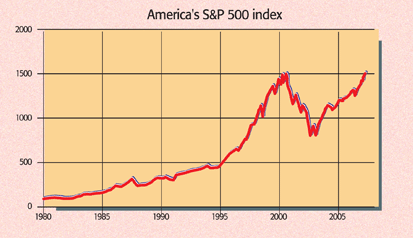
Most major markets have been closing in on their 2000 peaks. Last week, though, the world’s most widely watched stock index – America’s S&P 500 – finally closed above its 2000 record of 1,527. But foreign investors won’t be celebrating just yet; in euro terms, the index is down by about 30%. What’s more, adjusting for inflation, local investors are still out of pocket by 20%, says investment adviser Rathbones.
Still, it’s good news for the bulls, who have also been encouraged by the fact that long-time bear Richard Russell, editor of Dow Theory Letters, has changed his tune. Russell, who “has a stellar long-term market timing record”, as Mark Hulbert points out on Marketwatch.com, turned bearish on the secular trend in late 1999 and stuck to this view until last month. He had dismissed the upswing of the past four years as a bear rally within a primary downtrend. But he has now decided that the Dow’s post-2000 slide was merely a correction in the bull market that started in 1982 and that its final, most speculative phase – in which small investors, hitherto wary, rush into stocks – lies ahead.
So are we at the beginning of the end of a long bull market, rather than at the end of the beginning of a long bear market? Either way, the outlook for US stocks hardly seems compelling. The economy and profit growth are both slowing and the S&P’s p/e of 18, while much lower than the 2000 figure of 30, remains above the historic average, implying low long-term returns from here. And the credit boom fuelling the takeover market rests on rocky foundations. Thanks to increasingly lax lending standards in private-equity deals, “it is only a question of when” things go wrong, as fund manager Anthony Bolton notes. And the FT’s Gillian Tett highlights the risk in credit derivatives, the growth of which has fuelled the appetite for debt. Their ability to disperse risk has yet to be tested by a major world downturn or large economic shock.
Just about every asset class has been sent sky-rocketing by the liquidity boom of the past few years, says legendary investor Jeremy Grantham. So what might end the global bubble? A surge in inflation, which would necessitate higher interest rates, is one possible catalyst, he reckons. But – and here his view chimes with Russell’s – we’re not there yet: the global bubble has yet to reach a final, manic phase.